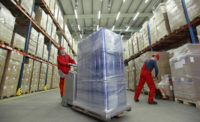Report shows cold storage gaining favor with investors for traditional warehouses
However, challenges stemming from the specialized nature of the sector will continue to restrain additional growth in transaction volume.

Investors increasingly are warming up to the U.S. cold storage warehousing sector, pushing cap rates for class A facilities closer to those of traditional high-quality warehouses, according to a new report from CBRE, Los Angeles.
This report outlines how trends such as the anticipated growth of online grocery sales have narrowed the gap in cap rates between cold storage warehouses and dry storage facilities to 75 basis points (bps) from 200 bps in the past three years.
Cap rates, formally called capitalization rates, measure a property’s annual income as a percentage of its price. A lower cap rate indicates a higher price. CBRE forecasts that the cap-rate spread between U.S. cold storage real estate and dry storage could narrow further to 25 bps, on par with the spread in leading Asia Pacific markets, as cold storage cap rates go lower.
“Cold storage facilities typically have accounted for a tiny fraction of overall transaction volume in U.S. industrial and logistics real estate, but we foresee investor activity accelerating amid heightened interest in this sector,” says Matthew Walaszek, associate director of industrial and logistics research. “Investors see cold storage warehouses as less risky than in the past, and they’re willing to accept less of a return premium, which is shown by the shrinking gap between cold storage and dry warehousing cap rates.”
Transaction volume for U.S. cold storage real estate has increased at an annual rate of 6.2% since 2014. A large share of transaction activity has focused on properties in major markets, including Los Angeles, Chicago, Dallas-Fort Worth and South Florida. In addition, investment opportunities can be found in secondary markets such as St. Louis, Milwaukee, Tampa, Cleveland, Baltimore and Savannah.
However, challenges stemming from the specialized nature of the sector will continue to restrain additional growth in transaction volume. CBRE’s report points out that available properties are scarce, construction is expensive and the design and operation of these facilities is complex. These challenges are likely to be addressed gradually by growth in the ranks of specialized developers and builders of cold storage as well as additional capital flowing into the industry.
“Historically, there have not been many institutional investors interested in the cold storage sector, but given the tremendous growth expectations for online food purchases, the sector is experiencing increasing demand from both domestic and global investors,” says Jack Fraker, vice chairman and managing director of CBRE industrial and logistics capital markets.
Looking for a reprint of this article?
From high-res PDFs to custom plaques, order your copy today!







